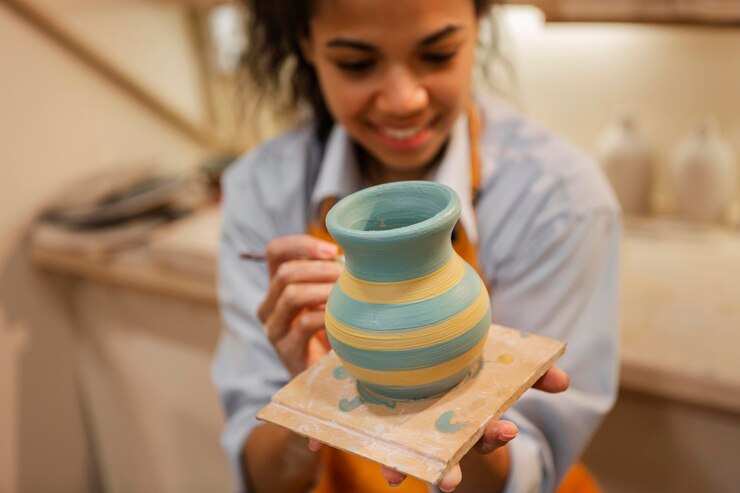- Discover the therapeutic benefits of engaging in ceramics.
- Learn about essential tools and techniques for beginners.
- Explore various ceramic styles and their historical contexts.
- Understand the importance of community studios in fostering artistic growth.
- Find tips for sourcing inspiration for your ceramic creations.
The Art Of Ceramics: Beyond The Wheel
Ceramics is a time-honored art form that has captivated human creativity for countless generations. This tactile craft is celebrated for its functionality and ability to connect us to a lineage of artistic expression dating back thousands of years.
The journey of crafting with clay invites a curious exploration of art and mindfulness. At its core, ceramics is about being in the moment, lost in a world where the rhythm of spinning wheels or the tactile sensation of kneading clay becomes a comforting ritual. This art form allows you to create intentionally, offering peace and satisfaction that resonates beyond the finished piece.
Why Ceramics Is A Therapeutic Experience
The allure of ceramics lies not only in the art itself but also in its ability to offer a therapeutic escape from life’s daily stresses. According to research on art therapy, engaging in artistic activities such as pottery significantly boosts mental health by reducing anxiety, enhancing mood, and promoting relaxation through focused, repetitive actions. Whether exploring this craft as a budding artist or simply looking to dive into a new, satisfying hobby, enrolling in a Ceramics Class can be the perfect gateway to unlocking your creative potential.
Working with clay engages the hands and mind, using neural pathways that encourage creativity and mental agility. As you mold and shape each piece, you’re invited to express yourself freely, achieving a balance between concentration and relaxation. The therapeutic benefits of this creative process are well-documented, making ceramics an excellent choice for those seeking personal growth alongside artistic expression.
The Basics: Tools And Techniques
Beginning your journey in ceramics involves embracing the basics, which starts with familiarizing yourself with the essential tools and techniques. Each tool has its specific purpose, and understanding its functions can make your transition into this art form more enjoyable.
- Clay: The type of clay you choose lays the groundwork for your project. Options like earthenware, stoneware, and porcelain offer varying textures, strengths, and firing temperatures. Stoneware is recommended for beginners due to its versatility and forgiving nature.
- Wheel Throwing: This enduring technique uses a potter’s wheel to shape the clay. Mastery of the wheel can take time, patience, and practice, allowing you to create everything from simple bowls to complex vases and ornate pottery pieces.
- Hand Building: Hand-building provides creative freedom for those who prefer a more personal touch or lack access to a potter’s wheel. Techniques like pinching, coiling, and slab construction offer limitless possibilities for unique, intricate designs obtained solely through manual effort.
Exploring Various Ceramic Styles And Historical Contexts
Ceramics is a global art form, with styles and traditions as varied as the cultures it originates from. From the quiet elegance of Japanese Raku to the intricate patterns and vivid colors found in Moroccan pottery, each style offers insight into the cultural history and heritage it represents.
Understanding these historical contexts deepens your appreciation and can also inform and enrich your work. By drawing inspiration from traditional methods, contemporary artists pay homage to their predecessors while infusing modern techniques and personal touches into their creations, bridging bygone eras with today’s artistic landscape.
The Role Of Community Studios
Community studios are central to nurturing creativity and artistic growth. These spaces allow access to a wide range of tools and materials that might otherwise be unavailable to individual artists. Beyond practical resources, they create a nurturing environment where artists of all levels can thrive.
These studios foster community and collaboration, offering lessons, group projects, and exchanging ideas that enrich the artistic journey. By joining such a community, you immerse yourself in a supportive network that encourages learning, experimentation, and continuous personal and creative development.
Sourcing Inspiration For Your Ceramic Creations
Inspiration can arise from the world around you, whether it’s the delicate textures of nature, the intricate lines in architecture, or the simplicity of everyday objects. Many artists find that staying open to diverse experiences fuels their creative energy and broadens their artistic perspective. As a Design Week article noted, exploring new environments can open new creative pathways, prompting fresh ideas and innovative expressions in your ceramic work.
By allowing external influences to guide your creativity, you can blend various elements into your work, creating unique pieces that resonate with broader artistic dialogues. This approach helps you grow as an artist and enriches your work with a distinctive voice.
Common Questions Beginners Have About Ceramics
- How do I choose the right clay? For those new to ceramics, starting with stoneware is often beneficial due to its resilient nature and adaptability, making it easier to manage as you hone your craft.
- What if I don’t have access to a wheel? Hand-building is an excellent alternative that requires minimal tools. It allows you to explore your creative abilities through more personal and tactile methods.
- How long does a typical piece take to make? Crafting ceramics is a process that varies widely, depending on factors like complexity and drying time. Expect several hours to weeks from start to finish, with the journey just as fulfilling as the result.
Tips For Getting Started In Ceramics
If you’re eager to start your ceramics adventure, consider enrolling in a beginner’s class at a local community studio. Take the opportunity to learn foundational techniques and immerse yourself in different styles and materials. The most important aspect is to enjoy the process, allowing your creativity to unfold naturally. With practice and patience, ceramics can evolve into a rewarding passion that brings unlimited inspiration and fulfillment.




